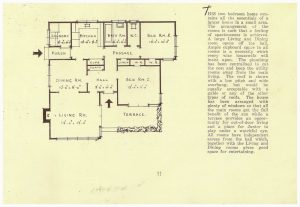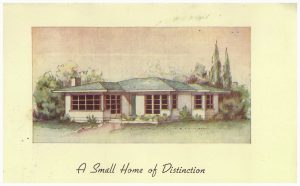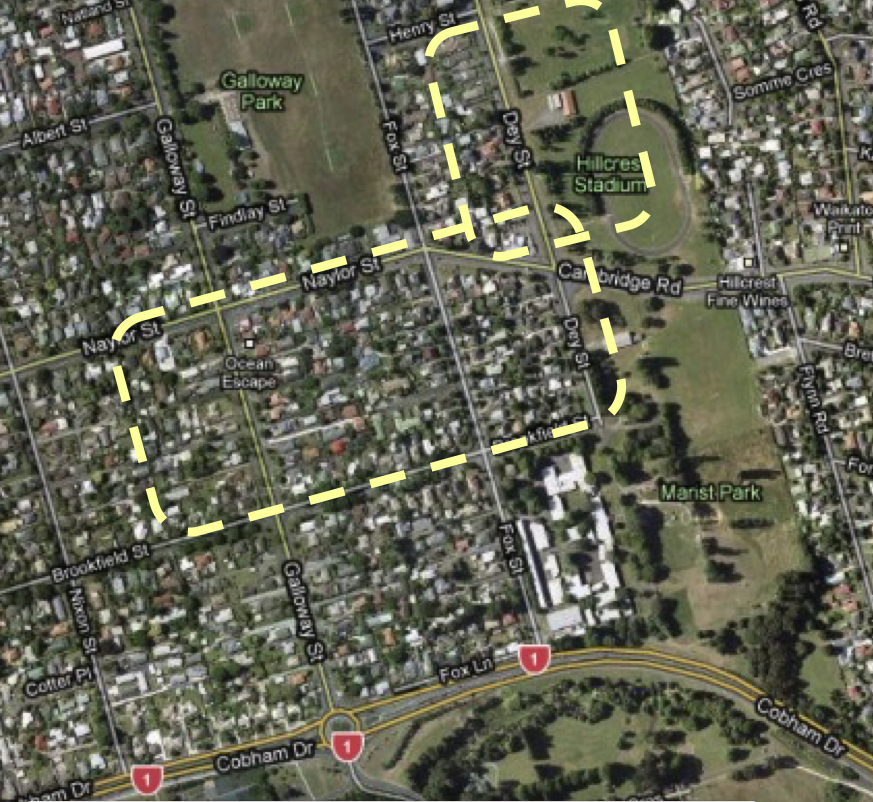Where East Meets West, The Californian Ranch Precinct of Hamilton East
Statement of article content category:
Category 6: case study that demonstrates excellence on practice, or “best practice”
The article describes a heritage inventory process, which has identified a significant precinct of New Zealand styled Californian Ranch houses, as part of a character and heritage study commissioned by the Hamilton City Council. The precinct is a reflection of the long-standing influence of the United States, particularly California, in the domestic architecture of New Zealand.
The concept of this mid 20th century style of house having heritage values, and hence a precinct of such house, has been challenging for the local authority, however the process of identification has followed best practice and the background research and heritage values analysis clearly shows the precinct to have sufficient heritage significance to warrant protection through town planning controls.
Role in the project: heritage inventory project leader carrying out visual and historical identification of potential built heritage, co-coordinating work of the historian, assisting with stakeholder consultation, creating and writing up a standard inventory sheet for each building and precinct, writing reports to Council, liaising with project team, writing hearing reports, attending and presenting at hearings.
Teaser
There has been a pervading American influence on New Zealand domestic architecture almost since Nantucket whalers fished the coasts from the 1790s.
Abstract:
This paper explores the more than 150 years of stylistic influence of the West Coast of the United States on the domestic architecture of New Zealand, with a particular emphasis on the Californian Ranch. This style is ubiquitous throughout New Zealand and the author has researched and analyzed a precinct in the Hamilton suburb of Hamilton East and he has proposed it for listing on the local Council’s heritage list. The precinct is intimately connected with the origins, growth and architectural development of the suburb, and reflects the local and national building industry, materials and technology of the immediate post-war period. The precinct is almost completely intact from the 1950s and is stylistically consistent and coherent.
Word count: 1885 words
PAPER
Introduction
New Zealand has had a long-standing connection with the West Coast of the United States beginning in the earliest years of European contact in the late 1790s. American whalers worked the coasts at this time, some settling in the country, others providing valuable early charts and one introducing the ‘merikana’ sweet potato, which were quickly adopted by the indigenous population.
Once European settlement became established from the 1840s onwards, almost all house styles were derived from the United States, with many of the most popular from California. These include the Italianate, plain and Bay Villa, Eastlake, American Colonial Georgian, Stick, Shingle, Californian Bungalow, Spanish Mission, the Bay Area and Californian Ranch styles.
The 19th century styles were introduced through American pattern books, which, carpenters and joiners copied. Within a short period much of the New Zealand timber industry was producing catalogues offering standardized timber elements based on these styles.
The 20th century styles were introduced through similar publications but the range was expanded to include magazines and catalogues. Early in the century New Zealand architects made study tours of California or trained through American correspondence courses. Later in the century some New Zealand architects gained post-graduate qualifications from architecture schools such as Berkeley while American architecture magazines were eagerly subscribed to, creating an awareness of American contemporary architecture.
The Californian connection also extends to the materials used to construct most New Zealand houses. In the mid 19th century two native Californian trees were introduced into New Zealand – the Monterey pine and the Monterey cypress. Large areas of the Monterey pine were planted during the depression to create work for unemployed men. This established the tree as the main building timber in the country and is now the dominant commercial timber species.
The domestic architecture of a suburb of New Zealand’s fourth largest city reflects this pattern of American architectural influence, particularly California. The last major period of growth in the suburb of the 1950s and 1960s saw the construction of a New Zealand version of the Californian Ranch. This paper explores the heritage significance of this precinct, how it relates to history of the growth and development of the area and the reasons for the popularity of the style.
The study
The local residents of Hamilton East, a suburb of Hamilton, a city in the upper half of the North Island of New Zealand, were concerned at the gradual and apparent increasing loss of significant buildings in their neighborhood. They canvassed their local council to curtail the damage being done to their built heritage and character.
The council commissioned a heritage and character study of the area to identify significant buildings for protection and to define the character of the suburb in order to draw up suitable planning rules. A team comprising independent and Council planners, a landscape architect, an urban designed, a conservation architect and an historian began the task in May 2008.
Over a period of over a year, the team made numerous site visits, consulted with residents several times, carried out extensive historic research into the area and individual buildings and reported on their findings to the Council. The report concluded that there was an issue with unsympathetic new buildings, relocation out of the area and demolition of significant buildings all of which contributed to a loss of character and heritage. It also concluded that there were 18 buildings and two precincts of sufficient heritage value to warrant inclusion in the District Plan heritage list. One of the precincts was of early 20th century bay villas and the other was a 1950s – 60s era of Californian Ranch styled houses.
Proposed planning rules were drawn up including listing the 18 individual heritage buildings and two heritage precincts. Submissions on the proposed planning rules from the public were called, and a Council hearing was held in August 2010. The new rules were confirmed, as were 16 of the 18 heritage buildings to be listed and the bay villa heritage precinct. A decision on the Californian Ranch precinct was deferred.
Brief history of housing construction in Hamilton East
The area where Hamilton East is located in known as the Waikato with the Waikato River running through it. British colonists considered it in the 1850s as having some of the best agricultural land in the county and there was considerable pressure by them to settle on it but Maori, the indigenous people, already occupied it. Waikato Maori refused to sell their land, resulting in armed conflict and confiscation.
After the wars, in 1864, the confiscated land was surveyed as a military settlement for soldiers who had fought for the British. 387 one-acre town sections were allocated to soldiers as well as 1000 feet of native timber. The area, known by local Maori as Kirikiriroa, was renamed Hamilton East and the soldiers became the first European settlers in the area.

Figure 1. Land subdivision for military land grants in 1864, Hamilton East
The expansion of the population, economic growth and the pattern of house construction occurred in five distinct periods, beginning with the soldiers’ settlement. As would be expected the houses in each of the periods reflect the styles popular at the time.
The first settlement period was in the 1860s to 1890s. Early in this period, the tents of soldiers gave way to Georgian box styled cottages constructed from the timber allocated to each soldier. Settlement was sparse and scattered throughout the area and in 1865 the population was only 250. The 1870s, however, saw a rapid economic expansion with railways being built throughout New Zealand including the Waikato. The government decided to put the rail line on the western side of the river creating a new town opposite Hamilton East. The original settlement became a suburb of the new town.

Figure 2. Georgian Box cottage, Hamilton East. Photo: I Bowman

Figure 3. Hamilton East from the Post Office. Hamilton City Library, photo reference 01277
Between the 1890s and 1915, the first impressions of the colonists that the area was ideal for farming were confirmed. Agricultural development and expansion saw the population increase to nearly 9,000 by 1915. The predominant house style was the plain and bay villa and housing was evenly scattered throughout the area on original one-acre sections.

Corner Bay Villa, Hamilton East, photo: I Bowman
Between 1916 and 1945 boom times of the mid 1920s and later 1930s saw the subdivision of the one acre section to quarter acre and the greater concentration of housing development in the centre of the town. The eastern and southern periphery of the town was market gardens. The predominant house style was the Californian bungalow. Other styles included the Spanish Mission, Arts and Crafts, English Domestic Revival, Moderne and Art Deco.
The rise of the Californian Ranch
In the immediate post-war era there was a huge housing shortage. This was caused by a shortage of building materials and almost no housing construction during the war. There was a nationwide housing boom and a number of national and local house construction and design companies were established. The government also built a considerable number of houses for rental to poorer workers.
The early 1950s saw the development of timber factories mass-producing timber frames for housing using Monterey pine from the forests planted in the 1930s. House construction companies continued the tradition of producing catalogues of house designs from which clients could choose. Architects and designers also published their own plan books, such as the “New Zealand Home Builder” by Leighton Carrad.

Figure 5. Plan of a Californian Ranch in Hamilton Eliis and Burnard, Practical Home Designs, 2nd Edition


Figure 6. Californian Ranch, Hamilton East. Photo: I Bowman
The predominant style in all housing construction in the period was the Californian Ranch as it was cheap to build, easy to modify without significant additional cost, and used readily available materials. “The Sunset” magazine was also influential in promoting the Western US lifestyle and housing styles.
The key characteristics of the houses are single storey, rectangular ‘U’, ‘L’, of ‘W’ floor plans, horizontal lines, low pitched gable or hipped roofs with wide overhanging eaves, a long shallow or a recessed entrance porch, an attached garage projecting beyond the main block of the house and large “picture windows” in the living room and a sliding glass ‘patio’ door at the rear. Massive brick or stone chimneys on the front or other visible elevations were popular.
The post war years in Hamilton were very prosperous and the city expanded very rapidly, growing at the greatest rate in New Zealand with the exception of Upper Hutt. Hamilton was at an important railway junction, a hub for servicing South Auckland, Waikato, Bay of Plenty and central North Island, and there was a consequent expansion in industry, and a booming agricultural sector. There was a dramatic acceleration of land subdivision and development. Between 1939 to 1969, over 1000 houses were constructed in Hamilton East with government or private developments and more than 50% of the current housing stock was built in this period.
The nationwide pattern of house construction and design was copied in Hamilton East. Building company designs were promoted through exhibitions copying London’s “Parade of Homes” held at the Olympia in the 1950s. One such building firm was Ellis and Burnand who owned a forest of Monterey pine, built their own mill and framing factory and who regularly published “Practical Home Design”.
The former market gardens located on the south and east of the suburb were subdivided and this area was built on between the late 1940s and 1960s, all houses in this and other areas of Hamilton East being designed in the Californian Ranch style. Several streets in this area comprise the proposed Californian Ranch precinct, with little visible change since the 1950s.

Figure 7. Californian Ranch, Hamilton East. Photo: I Bowman

Figure 8. Aerial photo of Hamilton East, 1950s, showing location of Californian Ranch precinct, photo Hamilton Library HCL 11125

Google Earth photo of Hamilton East showing location of Californian Ranch precinct
Almost all houses were of timber frame with many having an external veneer of brick manufactured in nearby Huntly. The use of external brick was largely a requirement of the main lender of the time, the Government-owned States Advances Corporation.
The post 1960s period saw development unsympathetic to the firmly established character of Hamilton East. Quarter acre sections were subdivided and infilled. Sections were amalgamated and two storied, elongated blocks of flats were built, colloquially known as “sausage flats”. It was this ongoing development that concerned local residents who felt that the built pattern up to the mid 1960s was significant and worth protecting.
Conclusions on the significance of the Californian Ranch and the precinct in Hamilton East
The Californian Ranch was the most popular style for housing for new subdivisions in New Zealand in the 1950s and 60s and examples are still being built today. It reflects the over 150 years of influence of American house styles on the New Zealand domestic building industry, particularly those of California. Not only were the house styles imported from the United States, but so too were the technology and materials, particularly the Monterey cypress and Monterey pine.
Although a ubiquitous and common style throughout New Zealand, the precinct of Californian Ranch style houses is a stylistically consistent, coherent and authentic precinct. It is locally significant as it represents the growth and development of Hamilton East during the post World War II building boom and was the fourth and a major era of subdivision in the suburb. The house designs were those of local builders copying and adapting the Ranch style seen in American and New Zealand publications of the time. The style was cheap to build and plans easily adapted to suit client’s budgets and tastes.
While only 50 to 60 years old, the retention and protection of the precinct is to be encouraged otherwise its integrity may be lost and with it a key element of local identity.
Bibliography
Carrad, Leighton, Guide to Home Building Materials and Building your Home – first edition, 19–
Ellis & Burnand, Half a century of Progress in the timber industry of New Zealand 1903-1953 (Hamilton: Ellis & Burnand, 1953)
Ellis & Burnand, Practical Home Designs for today and tomorrow – second edition (Hamilton: Ellis & Burnand, 1960s)
Gainsford, J, Hamilton Heritage Precinct – 1950s And 1960s Domestic Housing, unpublished report for the Hamilton City Council, January 2009
Porteous, Diana, Lesley, Hamilton East: interpretation of house styles and infilling the one acre sections, M.Soc.Sc. Geography thesis, University of Waikato, 1991
Porteous, Diana, Lesley, The rural image of the Hamilton East house – Inaugural joint conference of the New Zealand Geographical Society & Institute of Australian Geographers, vol 2, Auckland, January 1992
Shaw, Peter, A History Of New Zealand Architecture (Auckland: Hodder Moa Beckett, 1997)
Stacpoole, John, Colonial Architecture (Wellington: A.H. & A.W. Reed Ltd., 1976)
Toomath, William Built in New Zealand: The Houses We Live In (Wellington: Harper Collins, 1996)


